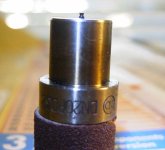SkyPup
Elite Member
- Joined
- Dec 3, 2003
- Messages
- 3,079
- Location
- North Central, Florida
- Tractor
- Kubota L-39 GST TLB, Kubota L3130GST, Massey 1030 HST, Kubota ZD-21 ProDecK, Two Euro VW TDIs
Combustion in these Kubota's is limited by the fuel-air supply, specifically to meet current Tier 1 and future Tier II Federal emission levels for agricultural tractor engines. Generally, there is quite an excess of air even in a naturally aspirated diesel since it operates over such a large air-fuel ratio (1:10 to 1:100) depending on the load. An increase in fueling by 20% should be atainable before too much smoke and soot occur from overfueling. Long term operation under extremely heavy load (>4-5 minutes at a time) with increased fueling would also be something to watch as increasing the fueling will directly increase EGT with correspondingly higher piston, upper ring, and exhaust valve temps
Kubota has redesigned these diesel engines to incorporate their new TVCS (Three Vortex Combustion Chamber). The D-1503M engine in my 2004 Grand L-3130 also has their most recent TVCS-E series combustion chamber design to take advantage of the three vortex induction swirl configuration with a newly designed tapered injection throat to force more air into the specially concave recess on the new piston head to obtain better combustion efficency i.e. less emissions (soot, hydrocarbons, and carbon monoxide). This engine series also has new injection nozzles with smaller orifices to match this low emission combustion chamber design as well. Perhaps the larger injection nozzles from older engines in the model series would fit the bill?
The D-1503M engine series also has a new metal head gasket and different coolant passages to reduce the upper most piston ring operational temperature by >25 degress Centrigrade for cooler operation and longer life (also the piston is coated with molybdenum oxide to reduce friction considerably). This has helped to limit the high temperature flame front to contact with the piston recess area, reducing metal fatigue and stress on the entire combustion chamber.
I've contacted some professional FIE engineers in Europe to investigate the injectior and nozzles utilized by NipponDenso on this engine series and will see what they can find out about upgrading these nozzles to a higher fueling event during the proper crank angle injection window. They said they would custom extrude hone some nozzles for me to experiment with, they would require me to send them one of my current nozzles to examine using an electron microscope to record the nozzles exact orifice diameter as well as their geometric orientation in the combustion chamber.
Kubota has redesigned these diesel engines to incorporate their new TVCS (Three Vortex Combustion Chamber). The D-1503M engine in my 2004 Grand L-3130 also has their most recent TVCS-E series combustion chamber design to take advantage of the three vortex induction swirl configuration with a newly designed tapered injection throat to force more air into the specially concave recess on the new piston head to obtain better combustion efficency i.e. less emissions (soot, hydrocarbons, and carbon monoxide). This engine series also has new injection nozzles with smaller orifices to match this low emission combustion chamber design as well. Perhaps the larger injection nozzles from older engines in the model series would fit the bill?
The D-1503M engine series also has a new metal head gasket and different coolant passages to reduce the upper most piston ring operational temperature by >25 degress Centrigrade for cooler operation and longer life (also the piston is coated with molybdenum oxide to reduce friction considerably). This has helped to limit the high temperature flame front to contact with the piston recess area, reducing metal fatigue and stress on the entire combustion chamber.
I've contacted some professional FIE engineers in Europe to investigate the injectior and nozzles utilized by NipponDenso on this engine series and will see what they can find out about upgrading these nozzles to a higher fueling event during the proper crank angle injection window. They said they would custom extrude hone some nozzles for me to experiment with, they would require me to send them one of my current nozzles to examine using an electron microscope to record the nozzles exact orifice diameter as well as their geometric orientation in the combustion chamber.
